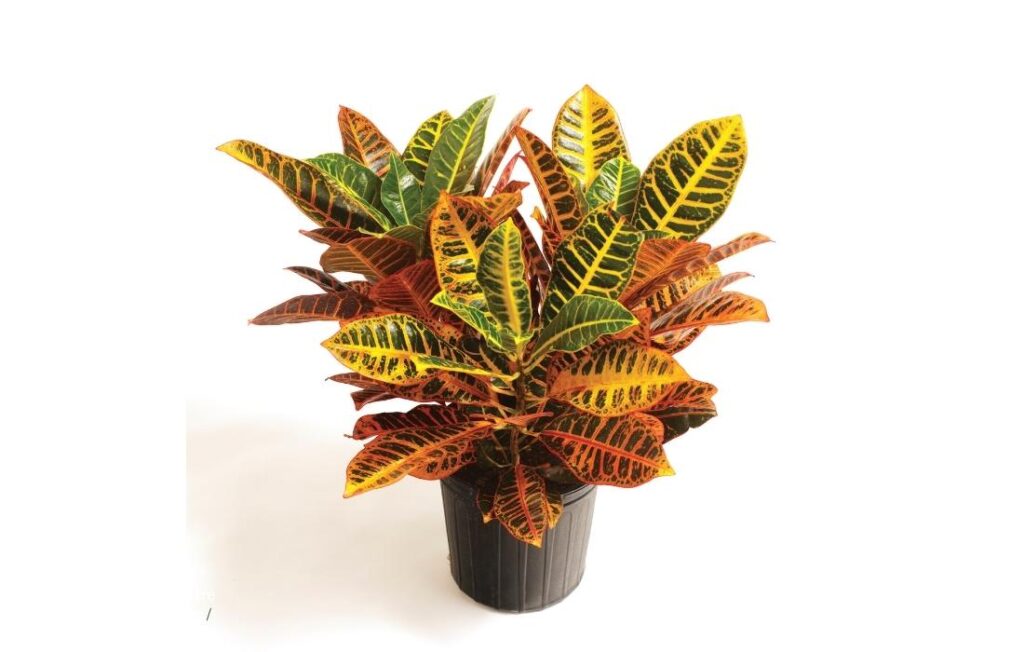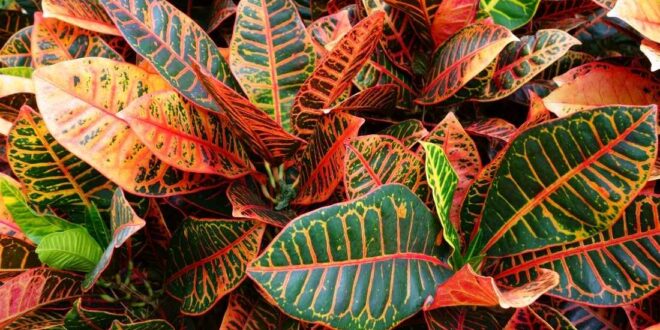Meet the Croton Plant
The Croton Plant – Codiaeum variegatum , commonly known as the Croton, is a stunning tropical plant celebrated for its spectacularly colorful and diverse foliage. With leaves that can display a vibrant palette of reds, oranges, yellows, greens, and even purples, Crotons add an instant splash of exotic beauty to any indoor or outdoor space in warm climates. Although their stunning appearance might suggest high maintenance, understanding their specific needs will allow you to enjoy their dazzling display.

This guide provides a comprehensive overview of Croton plant care, covering essential aspects such as light, watering, humidity, soil, and how to maintain their brilliant hues.
Why Choose a Croton Plant?
Crotons are undeniably eye-catching. Their glossy, leathery leaves come in various shapes and sizes, often exhibiting bold patterns and contrasting colors that can brighten any corner. They are a statement plant that adds a touch of the tropics to your home or garden. While they can be a bit more particular than some other houseplants, the reward of their vibrant foliage makes the extra attention worthwhile for many plant enthusiasts. Understanding Croton plant care is key to enjoying these benefits.
Essential Tips for Croton Plant Care
Light Requirements

To maintain their intense and varied colors, Crotons need bright, direct sunlight. Insufficient light will cause their vibrant hues to fade, and the plant may become leggy. Therefore, placing them in south or west-facing windows is ideal, as these locations typically provide the intense light that Crotons crave indoors. If moving a Croton outdoors for the warmer months in suitable climates, acclimate it gradually to direct sunlight over a week or two to prevent leaf scorch. Additionally, rotate your Croton regularly to ensure all sides receive even light, promoting uniform color development and preventing it from leaning excessively. This is a fundamental aspect of Croton plant care.
Watering and Moisture
During the active growing season (spring and summer), Crotons prefer consistently moist soil. Water thoroughly when the top inch of soil feels slightly dry to the touch. When watering, ensure the water reaches the roots by watering thoroughly until it drains from the bottom of the pot. Be sure to discard any excess water in the saucer. During the cooler, less active winter months, allow the top inch or two of soil to dry out before watering. Reduce the frequency but avoid letting the soil dry out completely for extended periods. Crotons can be sensitive to both extremes; overwatering can lead to root rot, while underwatering can cause leaf drop. Therefore, pay close attention to the soil moisture, which is crucial for effective Croton plant care.
Humidity Preferences
Native to tropical regions, Crotons thrive in high humidity levels, ideally above 60%. Dry air can lead to crispy leaf edges and spider mite infestations. To increase humidity, consider using a humidifier, which is the most effective way to maintain consistent high humidity. Alternatively, place the pot on a tray filled with pebbles and water (ensuring the pot base is above the water level), group plants together to create a more humid microclimate, or mist the leaves regularly with room temperature water, especially during dry indoor periods. These steps are vital for Croton plant care.
Temperature Preferences
Crotons prefer warm, consistent temperatures between 18-29°C (65-85°F). Avoid cold drafts and fluctuations, as protecting your plant from sudden temperature changes and proximity to heating or cooling vents is crucial. These conditions can stress the plant and lead to leaf drop. Furthermore, avoid exposing the plant to temperatures below 15°C (60°F). Maintaining the right temperature is an integral part of Croton plant care.
Soil Requirements
Use a well-draining potting mix that is also rich in organic matter. A mix formulated for tropical plants or a blend of general-purpose potting mix with added peat moss or compost works well. Ensure the soil provides good aeration to prevent root rot. Repot your Croton every 1-2 years, typically in the spring, or when it outgrows its current container. Choose a pot that is only slightly larger than the previous one. Proper soil management is a key element of Croton plant care.
Fertilizer
During the active growing season (spring and summer), feed your Croton every 2-4 weeks with a balanced liquid houseplant fertilizer diluted to half the recommended strength. This supports their vibrant colors and healthy growth. Reduce or stop fertilizing during the fall and winter months when the plant’s growth naturally slows down. Crotons can benefit from occasional applications of micronutrient fertilizers to maintain the intensity and variety of their colors. Fertilization is an important part of Croton plant care.
Pruning
Prune your Croton to maintain its desired size and shape, as they can sometimes become leggy over time. Pinching back the tips of the stems can encourage branching and a fuller appearance. Regularly remove any yellowing, brown, or damaged leaves to maintain the plant’s health and aesthetics. Spring or early summer is the best time for more significant pruning. Pruning is a practical aspect of Croton plant care.
Propagation of Croton Plant

Crotons can be propagated through stem cuttings, although it can be a bit more challenging than some other houseplants. Take a stem cutting that is about 4-6 inches long, ensuring it has at least 2-3 leaves. Remove the lower leaves, leaving a few at the top, then dip the cut end in rooting hormone. Plant the cutting in a moist, well-draining potting mix. Cover the pot with a clear plastic bag or place it in a propagator to create a humid environment. Place the cutting in a warm, bright location with indirect light. Rooting can take several weeks, so maintain consistent moisture and humidity. Propagation is an exciting part of Croton plant care.
Common Issues and Troubleshooting in Croton Plant Care
Leaf Drop
Sudden temperature changes or cold drafts are very common causes. Ensure the plant is in a stable, warm environment. Overwatering or underwatering can also lead to leaf drop, so maintain consistent soil moisture, allowing the top inch to dry slightly. Increase humidity levels if needed, and move the plant to a brighter location if it receives insufficient light. Stress from repotting or moving should be minimized by allowing the plant some time to adjust to new conditions. Addressing leaf drop is crucial in Croton plant care.
Faded Colors
Insufficient light is the primary reason for the loss of vibrant colors. Therefore, move the plant to a brighter location with direct sunlight. This is a vital consideration for Croton plant care.
Brown, Crispy Leaf Edges
Low humidity is often the culprit here. Increase humidity levels and ensure consistent soil moisture. Occasionally flush the soil with water to prevent salt buildup from fertilizer. Managing leaf health is a key part of Croton plant care.
Pests
Spider mites thrive in dry conditions. Increase humidity and treat infestations with insecticidal soap or neem oil. Regularly check stems and undersides of leaves for scale and mealybugs, and treat with appropriate insecticidal methods. Pest control is an essential aspect of Croton plant care.
Tips for Successful Croton Plant Care

- Provide bright, direct sunlight for the most vibrant colors.
- Maintain consistently moist soil during the growing season, allowing the top inch to dry slightly.
- Ensure high humidity levels.
- Keep the plant in a warm, stable environment, away from drafts.
- Use a well-draining, rich potting mix.
- Fertilize regularly during the spring and summer.
- Be patient; Crotons can sometimes be a bit temperamental with changes.
Caring for a Croton plant requires attention to its specific needs for light, warmth, and humidity. However, the breathtaking display of its colorful foliage makes it a truly rewarding addition to any plant collection. By providing the right conditions, you can enjoy the vibrant beauty of this tropical gem in your home or garden. With these Croton plant care tips, you’ll be well on your way to cultivating a thriving, colorful plant that enhances any space. Understanding and implementing effective Croton plant care will ensure your plant remains a stunning focal point in your home.





